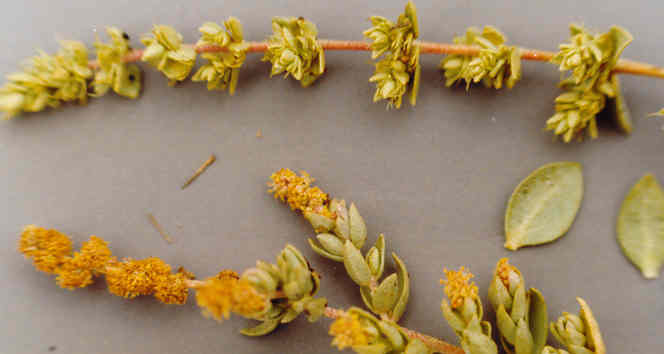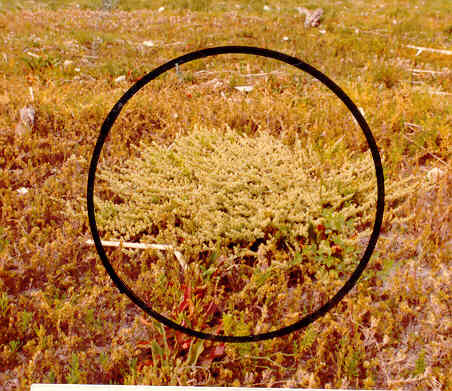
Atriplex watsonii Nelson
=A. decumbens
Chenopodiaceae (Goosefoot Family)
Native
 |
Atriplex watsonii Nelson=A. decumbensChenopodiaceae (Goosefoot Family)Native
Watson's Saltbush |
June Photo
Plant Characteristics:
Prostrate suffrutescent perennial forming tangled mats 1-3 m. across,
white-scurfy; lvs. numerous, mostly opposite, sessile, broadly elliptic to
ovate, entire, thick, white-scurfy, 8-25 mm. long acutish; plants dioecious, the
male glomerules in naked terminal spikes; the female clusters small, axillary;
fruiting bracts sessile, ovate to rhombic, 5-8 mm. long, entire to erose, united
to above the middle, the sides plane; seed light brown, ca. 1 mm. long.
Habitat:
Coastal bluffs and beaches; Coastal Strand, Coastal Salt Marsh, Coastal
Sage Scrub; Santa Barbara Co. to L. Calif.; Santa Catalina, San Clemente Ids.
March-Oct.
Name:
Atriplex is the ancient Latin
name for these plants. (Dale 95).
The species name is in honor of Sereno Watson
, (1826-1892). Watson was the assistant and later
successor to Asa Gray as director of the Harvard herbarium.
Like Gray, he was the author of many plant species.
He was the botanist of the King's expedition (a geological exploration of the 40th
parallel under Clarence King) and author of 2 volumes on the botany of Calif.
(1876-1880). The New Latin
adjective, serenanus, was coined to
honor his name. (Jaeger 317).
General:
Occasional in the study area. Photographed
on the North Star Flats and along the path between 23rd Street and Delhi. One of
the native halophytes found in Upper Newport Bay; for a complete list see Spartina
foliosa. (my comments).
Within the marsh, Beldings Savannah sparrow, an endangered species, has been seen to feed
on the seeds of Atriplex and the tips of Salicornia
and on insects in several habitats. (Zedler 82).
Atriplex species have been
known to cause hay fever and asthma. (Fuller
380).
Text Ref:
Abrams, Vol. II 84; Munz, Calif.
Flora 378; Munz, Flora So. Calif.
358.
Photo Ref:
May 5 83 # 2; June 4 83 # 19; Mar 1 84 # 4; April-May 84 # 23.
Identity: by R. De Ruff,
confirmed by F. Roberts.
First Found: May 1983.
Computer Ref: Plant Data 219.
Have plant specimen.
Last edit 6/7/04.
 |
May Photo